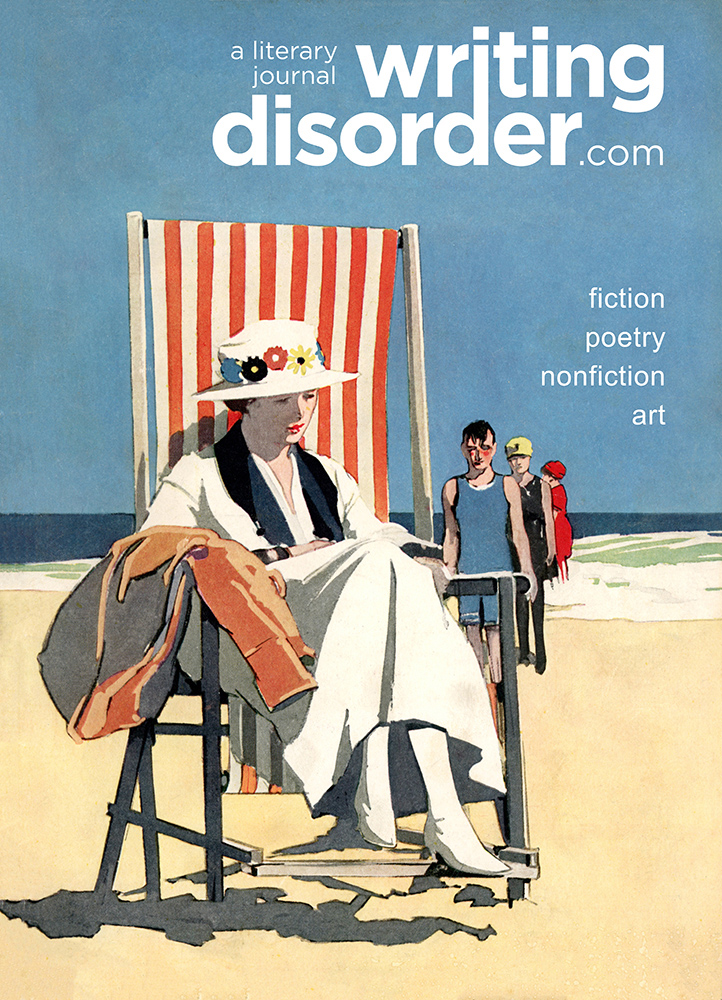Zone Valves
By Graeme Hunter
In early 1991, I interviewed for a faculty position at the University of Western Ontario. During my visit, a real-estate agent drove me around some residential areas in northwest London. I remember being impressed by Orchard Park, a quiet, leafy subdivision within cycling distance of campus.
I was offered the job, and accepted it. A few months later, my wife Francine went to London to find us a house. Unfortunately Orchard Park turned out to be too expensive for us. Her search narrowed down to two houses in White Hills, less leafy and a bit further from the university. She faxed me the details, and we made our decision.
At the end of the summer, Francine and I moved to London and took possession of our new house. It didn’t have much curb appeal: aluminum siding, a prominent garage, no street-facing windows on the main floor. But I already knew that from the photographs that Francine had taken. The unpleasant surprises began when we went inside. The living room was dark, with stuccoed walls. The bedrooms each had a different colour of carpet and a different type of garish wallpaper. Every renovation or repair had been done in the most half-assed manner imaginable. For example, the en-suite powder room, which I referred to as “the Black Hole of Calcutta”, was floored with sheet linoleum that curled up at the edges, because whoever installed it hadn’t bothered to remove the baseboards first.
Me: “This is so ugly!”
Francine: “I don’t remember it looking like this!”
But the low point was the dining room. It had a carpeted floor, and walls that were adorned with gold-patterned mirror tiles.
Me: “These tiles look like something you would find in a New Orleans cat-house.”
Francine: “How would you know?”
More unpleasant surprises lay behind the house’s walls and under its flooring. The wiring was aluminum, a known fire risk. The bedroom walls had never been primed, so stripping the wallpaper also removed the paper backing of the wallboard, as well as some of the underlying gypsum. Worst of all, the house had electrical baseboard heaters. Despite having access to vast amounts of free power from Niagara Falls, the province of Ontario had some of the highest electricity rates in the world. Heating our new house through the impending winter was going to bankrupt us.
We got rid of the baseboard heaters and installed a more efficient forced-air system. Now we had affordable electricity bills, but we also had gaps in our baseboards, holes in our walls and ceilings, and exposed ductwork running everywhere. This in addition to the bordello tiles, grotty carpeting, Age of Aquarius wallpaper, and all the other problems we had inherited.
In short, the place needed a lot of work.
Fortunately, help was at hand. Francine’s dad, Nick, was co-owner of a home-building company. He’d come to Canada from Italy with fifty dollars in his pocket and no marketable skills. By claiming to be a trained carpenter, he’d found a job on a building site, where he faked it until he learned the trade. After many years, he and a paesano were able to start their own business. Thanks to hard work, luck and bribes to municipal politicians, they became millionaires, at a time when that word was not yet synonymous with “home-owner”.
Nick and his wife were happy to come to London every weekend: she to play with her granddaughter, he to work on the house. The problem was that I was expected to help him, and I was emphatically not a handyman. Things got off to a bad start when Nick asked me for a hammer. When I brought him the only one I owned, he laughed. “That’s a child’s hammer!”
Way to emasculate your son-in-law, Nick! Don’t you want any more grandchildren?
Thereafter he brought his own tools, and we set to work: building a wall between the kitchen and dining-room, installing a French door, enclosing the new ductwork, tiling the carpeted floors. To elaborate on the plural pronoun: Nick did all the actual work, while I brought him the tools he needed. Once I had learned what “spikes” and “two-by-fours” were, and the difference between Phillips and Robertson screwdrivers, I was allowed to graduate to simple, hands-on tasks – such as using a proper, man-sized hammer to drive “spikes” into “two-by-fours”.
Nick believed in building things to last. Maybe it’s because he was Italian: the Coliseum is still standing, after all, and Rome’s first-century Pantheon looks like it was completed yesterday. The wooden frame Nick made to enclose the heating ducts was so robust that I could hang from it and do chin-ups. He brought the same philosophy to a closet he built in the family room. I decided that, if nuclear war broke out, the family would take shelter there. London might become a post-apocalyptic wasteland, but our family-room closet would still be standing.
Eventually Nick lost interest in spending every weekend working on his daughter’s house. Now I was on my own. Francine would have helped (or so she said), except that she was pregnant again. Apparently that was my fault! But I’d served my apprenticeship, and now knew the rudiments of home renovation: rough carpentry, drywalling, some wiring, a bit of plumbing. One of my solo projects was replacing the flooring in the Black Hole of Calcutta. When I took up the linoleum, which had a garish pink floral pattern, I was baffled to find beneath it another layer of the exact same lino! Below that was a layer of blue vinyl tiles. By the time I reached the subfloor, I felt like Schliemann at Troy.
Eventually I was proficient enough to build my own wall, although I had to get Nick out of retirement to hang the door in its opening. As far as I know, my wall is still standing, although I wouldn’t expect it to survive World War Three.
Throughout the disruptions of all these renovations, Francine and I consoled ourselves that this was just our starter home; in five years or so, we’d be able to move up in the world. But the mid-nineties were lean years for Ontario, and its university sector wasn’t spared. Even with help from Francine’s parents, it was nine years before we were able to think about house-hunting. By that time we had replaced every surface in the house. No more, I vowed. I’m hanging up my toy hammer. In the next house, I don’t want to do anything.
We found that house by accident. Cycling to work one morning, I came across an “open house” sign at the end of a street in Sherwood Forest, which was even leafier than Orchard Park. I detoured along the street and found the house. It was all brick, built on a centre-hall plan. When I got to work, I phoned Francine. We arranged that she’d pick me up at lunchtime.
I’d made a mistake. The house wasn’t open to the public – the sign I’d seen indicated a viewing for real-estate agents. But even though the property hadn’t been gussied up yet, the owner agreed to let us see it. A potential customer is a potential customer, after all. For the most part, the interior was as attractive as the exterior. Hardwood flooring throughout, crown moulding, large windows, a separate dining room, stained-glass panels flanking the front door. The basement was only semi-finished, but that wasn’t a deal-breaker – the house we were living in didn’t even have a basement.
There was only one thing wrong with the house – the asking price was more than Francine and I could afford. We made a lowball offer; the owners counteroffered. We found some spare change down the back of the sofa, and made a higher offer; the owners made a new counteroffer. But it was still too rich for our blood. We told our realtor to forget it, and I went off to a conference. A couple of days later, I phoned Francine from New Hampshire, and she told me that the owners of the Sherwood Forest house had decided to accept our second offer.
“Can they do that?” I asked.
Well, it turns out that they could. And, as a result, we had our dream home.
It was the beginning of November when we moved in, and it soon became obvious that the family room, which had been an addition to the original building, was unpleasantly cold. Unlike our previous house, this one had a hot-water heating system. And for some reason, the hot water wasn’t reaching the radiators in the addition.
So we called a plumber. He told us that we were lucky to have hot-water heating, because that was the best system. When we asked him why it was the best system, he explained that radiant heat was “warmer” than that produced by forced-air furnaces. I studied chemistry in my youth and retain a passing familiarity with the laws of thermodynamics. But I don’t understand how any form of heat can be “warmer” than any other form of heat, unless it’s actually, you know, at a higher temperature.
The plumber also explained that the family room, as well as about half of the original main floor, was on a separate “zone” from the rest of the house. Flow of hot water through each of the zones was governed by a valve, which was opened and closed by a thermostat in the corresponding part of the house.
Unfortunately he wasn’t able to fix the problem. Nor, as it subsequently turned out, were other plumbers who worked for his company, or plumbers who worked for different companies. No matter how much they tinkered with the system, the family room remained an uninhabitable meat-locker. Giving up, we installed a gas fireplace.
The fireplace kept the room warm for many years, although the noise of its blower was a bit annoying, particularly if you were watching television. But I had bigger problems, principally Francine being diagnosed with cancer. Five years after she died, I remarried, and my new wife moved into the house. Sue didn’t seem to understand that the stone-cold radiators in the family room were just a fact of nature. She thought we should get them fixed. So we started over again, this time with a new team of plumbers. Over the next few years, these gentlemen (and one lady) replaced various pipes, pumps, valves and gauges with shiny new pipes, pumps, valves and gauges. Unfortunately, all this work on their part, and expense on ours, resulted in at best a temporary warming of the family-room rads.
But at least by now I had learned enough about my heating system to converse intelligently about it with the plumbing profession. It seemed to me that the problem must be the zone valve controlling the addition. After all, if the shiny new boiler was heating water, and the shiny new pump was sending that water to the rest of the house through shiny new piping, surely the leading suspect was the valve controlling flow to the family room? However, a succession of plumbers “tested” the zone valve, and assured me that it worked perfectly. Look, Graeme, try it yourself. You just have to turn this wheel. Hear the click? That’s the sound of the valve opening. See, the wheel continues around until it’s back at the starting position. So the zone valve is fine. That will be three hundred dollars, please. Cash, check or credit card?
But, to paraphrase Sherlock Holmes, if every other part of your home-heating system has been replaced, then the one part that hasn’t been replaced, no matter how merrily it spins around, must be the culprit. I phoned the plumbing company once again and asked them to send someone to replace the zone valve. The woman in the office promised to do so, and assured me that, as it was a standard part, a new zone valve didn’t have to be ordered – the plumber would have one in his (or her) truck.
When the plumber arrived, he insisted on “checking the system” – in other words, performing a billable diagnostic procedure that I didn’t want or need. Then, when he admitted that maybe the zone valve was the problem, he told me that he didn’t have one with him, and would have to come back another day. But in the fullness of time it came to pass that the old valve was removed and replaced with a shiny new one.
When the plumber was packing up his kit, he told me that, just out of curiosity, he’d disassembled the old zone valve to see what the problem was. It turns out that the teeth of the spinning wheel were supposed to engage with those of another wheel mounted perpendicularly to it. However, the teeth of the invisible second wheel were stripped. Thus the visible wheel was turning, clicking, and doing absolutely nothing!
“How about that?” I said, parting with another five hundred dollars. Then I went upstairs and put my hand on the deliciously warm metal of the family-room radiators, doing their job at last.
BIO
Graeme Hunter‘s essays have been published in Riddle Fence, Queen’s Quarterly, Talking Soup, The Writing Disorder and Canadian Notes & Queries. His web site is https://graemehunter.ca/.

















